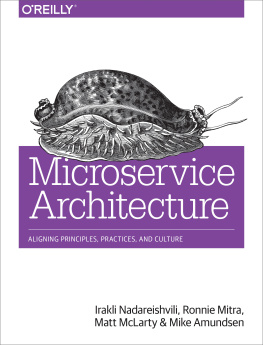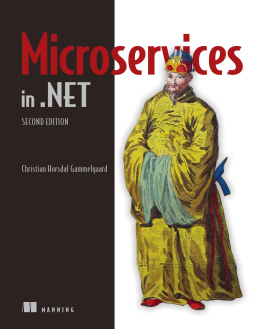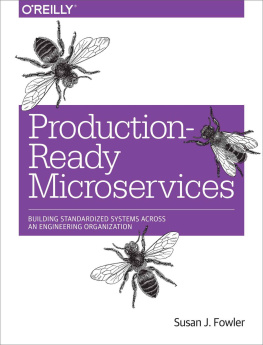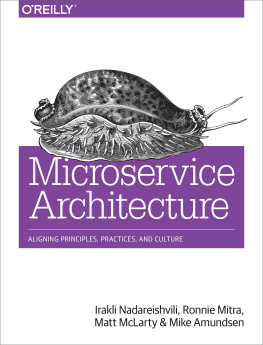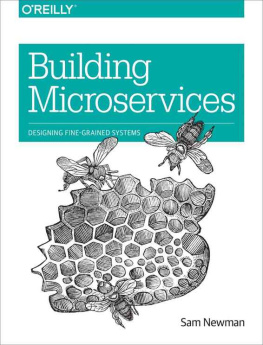Praise for Microservice Architecture
The authors approach of starting with a value proposition, Speed and Safety at Scale and in Harmony, and reasoning from there, is an important contribution to thinking about application design.
Mel Conway, Educator and Inventor
A well-thought-out and well-written description of the organizing principles
underlying the microservices architectural style with a pragmatic example of
applying them in practice.
James Lewis, Principal Consultant, ThoughtWorks
This book demystifies one of the most important new tools for building robust, scalable software systems at speed.
Otto Berkes, Chief Technology Officer, CA Technologies
If youve heard of companies doing microservices and want to learn more, Microservice Architecture is a great place to start. It addresses common questions and concerns about breaking down a monolith and the challenges youll face with culture, practices, and tooling. The microservices topic is a big one and this book gives you smart pointers
on where to go next.
Chris Munns, Business Development ManagerDevOps, Amazon Web Services
Anyone who is building a platform for use inside or outside an organization should read this book. It provides enough a-ha insights to keep everyone on your team engaged, from the business sponsor to the most technical team member. Highly recommended!
Dave Goldberg, Director, API Products, Capital One
A practical roadmap to microservices design and the underlying cultural and organizational change that is needed to make it happen successfully.
Mark Boyd, Writer/Analyst, Platformable
An essential guidebook for your microservices journey, presenting the concepts, discussions, and structures supportive of this architectural pattern as well as the pragmatic ground work to become successful.
Ian Kelly, Experimenter and Contributor, CA Technologies
Microservice Architecture
by Irakli Nadareishvili , Ronnie Mitra , Matt McLarty , and Mike Amundsen
Copyright 2016 Mike Amundsen, Matt McLarty, Ronnie Mitra, Irakli Nadareishvili. All rights reserved.
Printed in the United States of America.
Published by OReilly Media, Inc. , 1005 Gravenstein Highway North, Sebastopol, CA 95472.
OReilly books may be purchased for educational, business, or sales promotional use. Online editions are also available for most titles (http://safaribooksonline.com). For more information, contact our corporate/institutional sales department: 800-998-9938 or corporate@oreilly.com .
- Editors: Brian MacDonald and Holly Bauer
- Production Editor: Kristen Brown
- Copyeditor: Christina Edwards
- Proofreader: Kim Cofer
- Indexer: WordCo Indexing Services, Inc.
- Interior Designer: David Futato
- Cover Designer: Karen Montgomery
- Illustrator: Melanie Yarbrough
Revision History for the First Edition
- 2016-06-02: First Release
- 2016-07-18: Second Release
See http://oreilly.com/catalog/errata.csp?isbn=9781491956250 for release details.
The OReilly logo is a registered trademark of OReilly Media, Inc. Microservice Architecture, the cover image, and related trade dress are trademarks of OReilly Media, Inc.
While the publisher and the authors have used good faith efforts to ensure that the information and instructions contained in this work are accurate, the publisher and the authors disclaim all responsibility for errors or omissions, including without limitation responsibility for damages resulting from the use of or reliance on this work. Use of the information and instructions contained in this work is at your own risk. If any code samples or other technology this work contains or describes is subject to open source licenses or the intellectual property rights of others, it is your responsibility to ensure that your use thereof complies with such licenses and/or rights.
978-1-491-95625-0
[LSI]
Preface
Microservice architecture has emerged as a common pattern of software development from the practices of a number of leading organizations. These practices includes principles, technologies, methodologies, organizational tendencies, and cultural characteristics. Companies taking steps to implement microservices and reap their benefits need to consider this broad scope.
Who Should Read This Book
You should read this book if you are interested in the architectural, organizational, and cultural changes that are needed to succeed with a microservice architecture. We primarily wrote this book for technology leaders and software architects who want to shift their organizations toward the microservices style of application development. You dont have to be a CTO or enterprise architect to enjoy this book, but weve written our guidance under the assumption that you are able to influence the organizational design, technology platform, and software architecture at your company.
Whats In This Book
This book promotes a goal-oriented, design-based approach to microservice architecture. We offer this design-centric approach because, as we talked to several companies about their programs, we discovered one of the keys to their success was the willingness to not stick to a single tool or process as they attempted to increase their companys time-to-market while maintainingeven increasingtheir systems safety and resilience.
The companies we talked to offered a wide range of services including live video and audio streaming service, foundation-level virtual services in the cloud, and support for classic brick-and-mortar operations. While these companies products vary, we learned that the principles of speed and safety at scale were a common thread. They each worked to provide the same system properties in their own unique waysways that fit the key business values and goals of the company.
Its the properties and values that we focus on in this book, and the patterns and practices we see companies employ in order to reach their unique goals. If youre looking for a way to identify business goals for your microservices adoption, practical guidance on how to design individual microservices and the system they form, and tips on how to overcome common architectural challenges, this is your book!
The Outline
The book is organized into three parts. The first part (Chapters ) identifies the principles and practices of microservice architecture and the benefits they can provide. This section will be valuable to anyone who needs to justify the use of microservices within their organization and provide some background on how other organizations have started on this journey.
The second part (Chapters ) introduces a design-based approach to microservice architecture, identifies a series of common processes and practices we see repeated through successful microservice systems, and provides some implementation guidance on executing the various elements for your companys microservice implementation.
The third and final part (Chapters ) provides a set of practical recipes and practices to help companies identify ways to introduce and support microservices, meet immediate challenges, and plan for and respond to the inevitably changing business environment ahead.
Heres a quick rundown of the chapters:
This chapter outlines the principles, practices, and culture that define microservice architecture.
This chapter examines the benefits of microservice architecture and some techniques to achieve them.
This chapter explores the system aspects of microservices and illustrates a design process for microservice architecture.

